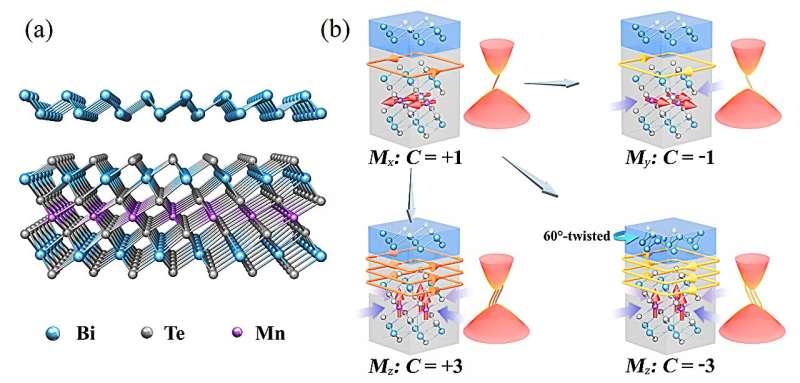(a) Crystal structure of Bi/MnBi2tellurium4 vdW heterostructure. (b) Schematic illustration of controllable magnetism and topological phase transitions in materials. Magnetization direction (MI: i = x, y, z; red arrow) can be tuned by applying strain (indicated by purple arrow) or magnetic field. QAH states with controllable Chern numbers are achieved by changing the magnetization direction or twisting the vdW heterostructure.Image source: China Science Press
The quantum anomalous Hall effect (QAHE) has unique advantages in topological electronic applications, but realizing QAHE with tunable magnetic and topological properties to build functional devices remains a key scientific challenge. Using first-principles calculations, the researchers predicted candidate materials that would meet these requirements.
Related work has recently been published in national science review The title is “Tunable quantum anomalous Hall effect in ferromagnetic van der Waals heterostructures”.
Professor Duan Wenhui and Professor Xu Yong from the Department of Physics of Tsinghua University are the co-corresponding authors of this paper. Xue Feng, a postdoctoral fellow in the Department of Physics of Tsinghua University and the Beijing Institute of Quantum Information Science, is the first author.
Other co-authors include Professor Wu Ruqian of the University of California, Irvine, Professor He Ke of Tsinghua University, Associate Professor Hou Yusheng of Sun Yat-sen University, Fudan University doctoral student Wang Zhe, and Tsinghua University doctoral student Xu Qiming.
The quantum anomalous Hall effect is a topological phenomenon characterized by the occurrence of quantized Hall conductance in the absence of an external magnetic field and has great potential for next-generation electronic devices.Through first-principles calculations of the system, the research team predicts that QAHE caused by in-plane and out-of-plane magnetization can be realized in a single material system composed of van der Waals coupled Bi and MnBi.2tellurium4 Single layer.
By applying strain, magnetic field, or twisting the material, the magnetic and topological properties of the system can be induced to change significantly, resulting in highly tunable QAHE states. This research not only provides a practical material platform for topological electronics, but also opens up new avenues for further experimental and theoretical exploration of the quantum anomalous Hall effect.
More information:
Feng Xu et al., Tunable quantum anomalous Hall effect in ferromagnetic van der Waals heterostructures, national science review (2023). DOI: 10.1093/nsr/nwad151
Provided by Science China Press
citation: Tunable Quantum Anomalous Hall Effect in Van der Waals Heterostructures (2024, April 23) Retrieved April 23, 2024, from https://phys.org/news/2024-04-tunable-quantum- anomalous-hall-effects.html
This document is protected by copyright. No part may be reproduced without written permission except in the interests of fair dealing for private study or research purposes. Content is for reference only.
#Tunable #quantum #anomalous #Hall #effect #van #der #Waals #heterostructures
Image Source : phys.org
